
Who do we target for Donations¶
- We have a dataset of people we approached for doners for our Election campaign
- We have their education, job, income, ethnicity
- We know high income earners are better to approach for political donations
Let's build a classifier that predicts income levels based on a person's attributes.¶
Those will be the persons we appraoch first for political donations
Feature explanation:
age: continuous. workclass: Private, Self-emp-not-inc, Self-emp-inc, Federal-gov, Local-gov, State-gov, Without-pay, Never-worked.
workclass: categorical data; different types of work class
fnlwgt: Final weight; Its a weight assigned by the US census bureau to each row. The literal meaning is that you will need to replicate each row, final weight times to get the full data. And it would be somewhat 6.1 billion rows in it. Dont be shocked by the size, its an accumulated data over decades.
education: Bachelors, Some-college, 11th, HS-grad, Prof-school, Assoc-acdm, Assoc-voc, 9th, 7th-8th, 12th, Masters, 1st-4th, 10th, Doctorate, 5th-6th, Preschool.
education-num: continuous.
marital-status: Married-civ-spouse, Divorced, Never-married, Separated, Widowed, Married-spouse-absent, married-F-spouse.
occupation: Tech-support, Craft-repair, Other-service, Sales, Exec-managerial, Prof-specialty, Handlers-cleaners, Machine-op-inspect, Adm-clerical, Farming-fishing, Transport-moving, Priv-house-serv, Protective-serv, Armed-Forces.
relationship: Wife, Own-child, Husband, Not-in-family, Other-relative, Unmarried.
race: Black, White, Asian-Pac-Islander, Amer-Indian-Eskimo, Other.
sex: Female, Male.
capital-gain: continuous.
capital-loss: continuous.
hours-per-week: continuous.
native-country: United-States, Cambodia, England, Puerto-Rico, Canada, Germany, Outlying-US(Guam-USVI-etc), India, Japan, Greece, South, China, Cuba, Iran, Honduras, Philippines, Italy, Poland, Jamaica, Vietnam, Mexico, Portugal, Ireland, France, Dominican-Republic, Laos, Ecuador, Taiwan, Haiti, Columbia, Hungary, Guatemala, Nicaragua, Scotland, Thailand, Yugoslavia, El-Salvador, Trinadad&Tobago, Peru, Hong, Holand-Netherlands.
Income: Whether a person's income is more than $50,000 or not. This is our dependent variable.
We are going to create a classification model using Decision Tree, Random Forest, and XGBoost using Python. At the end we will compare the results to zero down on the best model.¶
import numpy as np
import pandas as pd
import os
from matplotlib import pyplot as plt
pd.options.mode.chained_assignment = None # removes warning messages
os.chdir("C:\\Users\\ASUS")
census = pd.read_csv("adult.csv")
census.head()
| age | workclass | fnlwgt | education | education-num | marital-status | occupation | relationship | race | sex | capital-gain | capital-loss | hours-per-week | native-country | Income | |
|---|---|---|---|---|---|---|---|---|---|---|---|---|---|---|---|
| 0 | 50 | Self-emp-not-inc | 83311 | Bachelors | 13 | Married-civ-spouse | Exec-managerial | Husband | White | Male | 0 | 0 | 13 | United-States | <=50K |
| 1 | 38 | Private | 215646 | HS-grad | 9 | Divorced | Handlers-cleaners | Not-in-family | White | Male | 0 | 0 | 40 | United-States | <=50K |
| 2 | 53 | Private | 234721 | 11th | 7 | Married-civ-spouse | Handlers-cleaners | Husband | Black | Male | 0 | 0 | 40 | United-States | <=50K |
| 3 | 28 | Private | 338409 | Bachelors | 13 | Married-civ-spouse | Prof-specialty | Wife | Black | Female | 0 | 0 | 40 | Cuba | <=50K |
| 4 | 37 | Private | 284582 | Masters | 14 | Married-civ-spouse | Exec-managerial | Wife | White | Female | 0 | 0 | 40 | United-States | <=50K |
Observation: Income is given as an object (character). We will modify this column as 1 (<=50K), else 0¶
#Unique values of Income variable
census.Income.unique()
array([' <=50K', ' >50K'], dtype=object)
#Frequency distribution of Income variable
census.Income.value_counts()
<=50K 24719
>50K 7841
Name: Income, dtype: int64
census["Income"] = np.where(census["Income"] == ' <=50K',0,1 )
#Frequency distribution of Income variable
census.Income.value_counts()
0 24719
1 7841
Name: Income, dtype: int64
Observation: Income variable has been correctly modified as 1 and 0¶
census.head(2)
| age | workclass | fnlwgt | education | education-num | marital-status | occupation | relationship | race | sex | capital-gain | capital-loss | hours-per-week | native-country | Income | |
|---|---|---|---|---|---|---|---|---|---|---|---|---|---|---|---|
| 0 | 50 | Self-emp-not-inc | 83311 | Bachelors | 13 | Married-civ-spouse | Exec-managerial | Husband | White | Male | 0 | 0 | 13 | United-States | 0 |
| 1 | 38 | Private | 215646 | HS-grad | 9 | Divorced | Handlers-cleaners | Not-in-family | White | Male | 0 | 0 | 40 | United-States | 0 |
Missing value Treatment¶
# number of missing values by variables
census.isnull().sum()
age 0
workclass 0
fnlwgt 0
education 0
education-num 0
marital-status 0
occupation 0
relationship 0
race 0
sex 0
capital-gain 0
capital-loss 0
hours-per-week 0
native-country 0
Income 0
dtype: int64
Observation: There are no missing values in the data¶
Exploratory Data Analysis (EDA)¶
#segregating the numeric and categorical variables
dataset_categorical = census.select_dtypes(exclude = "number")
dataset_numeric = census.select_dtypes(include = "number")
#create the dummy variables
#dataset_categorical= pd.get_dummies(data = dataset_categorical, drop_first = True)
dataset_categorical.head(2)
| workclass | education | marital-status | occupation | relationship | race | sex | native-country | |
|---|---|---|---|---|---|---|---|---|
| 0 | Self-emp-not-inc | Bachelors | Married-civ-spouse | Exec-managerial | Husband | White | Male | United-States |
| 1 | Private | HS-grad | Divorced | Handlers-cleaners | Not-in-family | White | Male | United-States |
dataset_categorical.describe(include='object')
| workclass | education | marital-status | occupation | relationship | race | sex | native-country | |
|---|---|---|---|---|---|---|---|---|
| count | 32560 | 32560 | 32560 | 32560 | 32560 | 32560 | 32560 | 32560 |
| unique | 9 | 16 | 7 | 15 | 6 | 5 | 2 | 42 |
| top | Private | HS-grad | Married-civ-spouse | Prof-specialty | Husband | White | Male | United-States |
| freq | 22696 | 10501 | 14976 | 4140 | 13193 | 27815 | 21789 | 29169 |
We can see that there are leading and/or trailing spaces¶
dataset_categorical["native-country"].unique()
array([' United-States', ' Cuba', ' Jamaica', ' India', ' ?', ' Mexico',
' South', ' Puerto-Rico', ' Honduras', ' England', ' Canada',
' Germany', ' Iran', ' Philippines', ' Italy', ' Poland',
' Columbia', ' Cambodia', ' Thailand', ' Ecuador', ' Laos',
' Taiwan', ' Haiti', ' Portugal', ' Dominican-Republic',
' El-Salvador', ' France', ' Guatemala', ' China', ' Japan',
' Yugoslavia', ' Peru', ' Outlying-US(Guam-USVI-etc)', ' Scotland',
' Trinadad&Tobago', ' Greece', ' Nicaragua', ' Vietnam', ' Hong',
' Ireland', ' Hungary', ' Holand-Netherlands'], dtype=object)
We will use the following code to remove all leading and trailing spaces from all variables¶
dataset_categorical= dataset_categorical.apply(lambda x: x.str.strip() if x.dtype == "object" else x)
We can see that there are instances where we have question marks ("?"). We will replace them by their respective mode¶
dataset_categorical["native-country"].value_counts()
United-States 29169
Mexico 643
? 583
Philippines 198
Germany 137
Canada 121
Puerto-Rico 114
El-Salvador 106
India 100
Cuba 95
England 90
Jamaica 81
South 80
China 75
Italy 73
Dominican-Republic 70
Vietnam 67
Guatemala 64
Japan 62
Poland 60
Columbia 59
Taiwan 51
Haiti 44
Iran 43
Portugal 37
Nicaragua 34
Peru 31
Greece 29
France 29
Ecuador 28
Ireland 24
Hong 20
Trinadad&Tobago 19
Cambodia 19
Laos 18
Thailand 18
Yugoslavia 16
Outlying-US(Guam-USVI-etc) 14
Hungary 13
Honduras 13
Scotland 12
Holand-Netherlands 1
Name: native-country, dtype: int64
#We will replace the ? (which seems to be missing value) with mode, i.e. United-States
dataset_categorical["native-country"]= dataset_categorical["native-country"].str.replace("?","United-States")
Observations: Distribution of native-country shows United-States alone is there for majority of the rows for this variable. Hence, we will not count rest of the countries separately, but club them together as others. Then we will code United-States as 1 and others 0 to create a dummy variable¶
dataset_categorical["native-country"].value_counts().plot(kind='bar', ylabel='frequency')
plt.show()
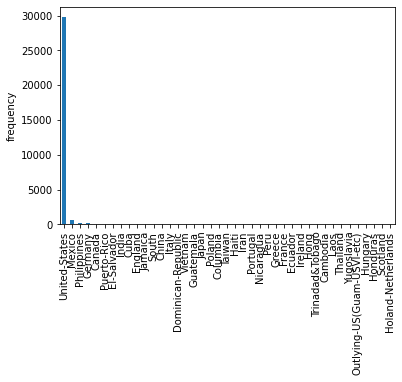
dataset_categorical["native-country"] = np.where(dataset_categorical["native-country"] == "United-States",1,0 )
Native-country has been converted into a dummy variable¶
dataset_categorical["native-country"].value_counts()
1 29752
0 2808
Name: native-country, dtype: int64
Now we will do the same treatment with other categorical variables¶
dataset_categorical["workclass"].value_counts()
Private 22696
Self-emp-not-inc 2541
Local-gov 2093
? 1836
State-gov 1297
Self-emp-inc 1116
Federal-gov 960
Without-pay 14
Never-worked 7
Name: workclass, dtype: int64
#We will replace the ? (which seems to be missing value) with mode, i.e. Private
dataset_categorical["workclass"]= dataset_categorical["workclass"].str.replace("?","Private")
dataset_categorical["workclass"].value_counts().plot(kind='bar', ylabel='frequency')
plt.show()
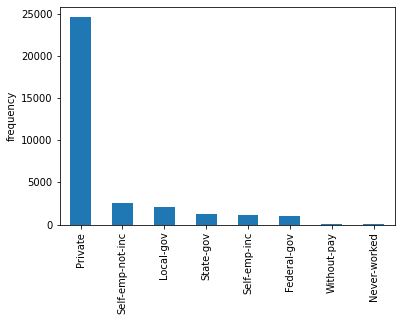
dataset_categorical["workclass"] = np.where(dataset_categorical["workclass"] == "Private",1,0 )
dataset_categorical["workclass"].value_counts()
1 24532
0 8028
Name: workclass, dtype: int64
dataset_categorical["occupation"].value_counts()
Prof-specialty 4140
Craft-repair 4099
Exec-managerial 4066
Adm-clerical 3769
Sales 3650
Other-service 3295
Machine-op-inspct 2002
? 1843
Transport-moving 1597
Handlers-cleaners 1370
Farming-fishing 994
Tech-support 928
Protective-serv 649
Priv-house-serv 149
Armed-Forces 9
Name: occupation, dtype: int64
#We will replace the ? (which seems to be missing value) with mode, i.e. Prof-specialty
dataset_categorical["occupation"]= dataset_categorical["occupation"].str.replace("?","Prof-specialty")
dataset_categorical["occupation"].value_counts().plot(kind='bar', ylabel='frequency')
plt.show()
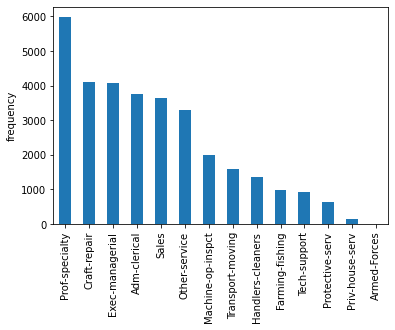
We will club the last 5 categories as "others" where the frequencies are less than 1000¶
dataset_categorical["occupation"] = np.where(dataset_categorical["occupation"].isin(["Farming-fishing",
"Tech-support","Protective-serv","Priv-house-serv","Armed-Forces"]),"others",dataset_categorical["occupation"])
dataset_categorical.head(2)
| workclass | education | marital-status | occupation | relationship | race | sex | native-country | |
|---|---|---|---|---|---|---|---|---|
| 0 | 0 | Bachelors | Married-civ-spouse | Exec-managerial | Husband | White | Male | 1 |
| 1 | 1 | HS-grad | Divorced | Handlers-cleaners | Not-in-family | White | Male | 1 |
Dummy Variable creation¶
dataset_categorical=pd.get_dummies(data=dataset_categorical,columns=['education', 'marital-status',
"occupation","relationship","race","sex"],drop_first=True)
All the dummy variables have been properly created¶
dataset_categorical.head(2)
| workclass | native-country | education_11th | education_12th | education_1st-4th | education_5th-6th | education_7th-8th | education_9th | education_Assoc-acdm | education_Assoc-voc | ... | relationship_Not-in-family | relationship_Other-relative | relationship_Own-child | relationship_Unmarried | relationship_Wife | race_Asian-Pac-Islander | race_Black | race_Other | race_White | sex_Male | |
|---|---|---|---|---|---|---|---|---|---|---|---|---|---|---|---|---|---|---|---|---|---|
| 0 | 0 | 1 | 0 | 0 | 0 | 0 | 0 | 0 | 0 | 0 | ... | 0 | 0 | 0 | 0 | 0 | 0 | 0 | 0 | 1 | 1 |
| 1 | 1 | 1 | 0 | 0 | 0 | 0 | 0 | 0 | 0 | 0 | ... | 1 | 0 | 0 | 0 | 0 | 0 | 0 | 0 | 1 | 1 |
2 rows × 42 columns
dataset_numeric.head(2)
| age | fnlwgt | education-num | capital-gain | capital-loss | hours-per-week | Income | |
|---|---|---|---|---|---|---|---|
| 0 | 50 | 83311 | 13 | 0 | 0 | 13 | 0 |
| 1 | 38 | 215646 | 9 | 0 | 0 | 40 | 0 |
The correlations are within control. We don't find any variable with correlation of .8 or more.¶
import seaborn as sns
import matplotlib.pyplot as plt
correlation_mat = dataset_numeric.corr()
sns.heatmap(correlation_mat, annot = True)
plt.show()
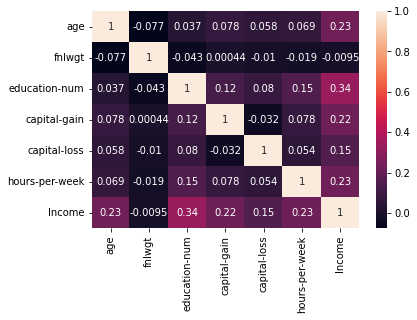
#Distribution plot
dataset_numeric.hist(figsize=(15,30),layout=(9,3))
array([[<AxesSubplot:title={'center':'age'}>,
<AxesSubplot:title={'center':'fnlwgt'}>,
<AxesSubplot:title={'center':'education-num'}>],
[<AxesSubplot:title={'center':'capital-gain'}>,
<AxesSubplot:title={'center':'capital-loss'}>,
<AxesSubplot:title={'center':'hours-per-week'}>],
[<AxesSubplot:title={'center':'Income'}>, <AxesSubplot:>,
<AxesSubplot:>],
[<AxesSubplot:>, <AxesSubplot:>, <AxesSubplot:>],
[<AxesSubplot:>, <AxesSubplot:>, <AxesSubplot:>],
[<AxesSubplot:>, <AxesSubplot:>, <AxesSubplot:>],
[<AxesSubplot:>, <AxesSubplot:>, <AxesSubplot:>],
[<AxesSubplot:>, <AxesSubplot:>, <AxesSubplot:>],
[<AxesSubplot:>, <AxesSubplot:>, <AxesSubplot:>]], dtype=object)
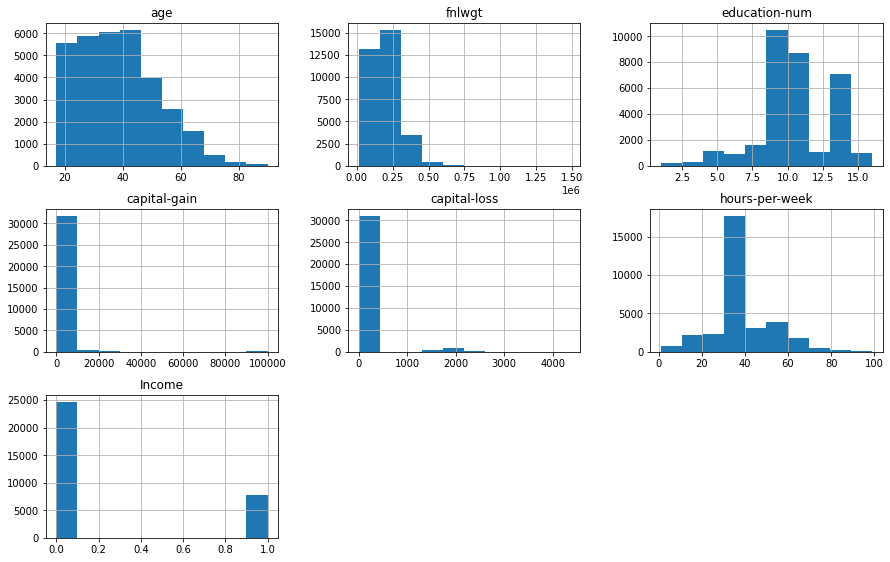
dataset_numeric.drop("fnlwgt",axis=1,inplace=True)
dataset_numeric.head(2)
| age | education-num | capital-gain | capital-loss | hours-per-week | Income | |
|---|---|---|---|---|---|---|
| 0 | 50 | 13 | 0 | 0 | 13 | 0 |
| 1 | 38 | 9 | 0 | 0 | 40 | 0 |
Concatenate the datasets to get the final data¶
#dataset_categorical = census.select_dtypes(exclude = "number")
#dataset_numeric = census.select_dtypes(include = "number")
data = pd.concat([dataset_categorical,dataset_numeric],axis=1)
data.head(2)
| workclass | native-country | education_11th | education_12th | education_1st-4th | education_5th-6th | education_7th-8th | education_9th | education_Assoc-acdm | education_Assoc-voc | ... | race_Black | race_Other | race_White | sex_Male | age | education-num | capital-gain | capital-loss | hours-per-week | Income | |
|---|---|---|---|---|---|---|---|---|---|---|---|---|---|---|---|---|---|---|---|---|---|
| 0 | 0 | 1 | 0 | 0 | 0 | 0 | 0 | 0 | 0 | 0 | ... | 0 | 0 | 1 | 1 | 50 | 13 | 0 | 0 | 13 | 0 |
| 1 | 1 | 1 | 0 | 0 | 0 | 0 | 0 | 0 | 0 | 0 | ... | 0 | 0 | 1 | 1 | 38 | 9 | 0 | 0 | 40 | 0 |
2 rows × 48 columns
#segregate data into dependent and independent variables
X = data.drop("Income", axis = 1)#independent variables
y = data["Income"]#dependent variable
Now we will split the data into training (80% of the data) and rest 20% - named test, will be kept aside for later use.¶
# Splitting it into training and testing (70% train & 30% test)
from sklearn.model_selection import train_test_split
X_train, X_test, y_train, y_test = train_test_split(X, y, test_size = 0.3, random_state = 42)
from sklearn.tree import DecisionTreeClassifier
classifier = DecisionTreeClassifier(random_state=0)
classifier.fit(X_train, y_train)
DecisionTreeClassifier(random_state=0)
Predict the model¶
y_pred = classifier.predict(X_test)
Check accuracy with Classification report¶
from sklearn.metrics import classification_report, confusion_matrix, accuracy_score
print(classification_report(y_test,y_pred))
precision recall f1-score support
0 0.87 0.89 0.88 7395
1 0.62 0.58 0.60 2373
accuracy 0.81 9768
macro avg 0.75 0.73 0.74 9768
weighted avg 0.81 0.81 0.81 9768
Collating the Report¶
report = classification_report(y_test,y_pred, output_dict=True)
df = pd.DataFrame(report).transpose()
#df
import numpy as np
df["model"]="Decision Tree"
df1 = df.iloc[0:3,np.r_[0:3,4] ]
df1
| precision | recall | f1-score | model | |
|---|---|---|---|---|
| 0 | 0.868724 | 0.886815 | 0.877677 | Decision Tree |
| 1 | 0.622803 | 0.582385 | 0.601916 | Decision Tree |
| accuracy | 0.812858 | 0.812858 | 0.812858 | Decision Tree |
from sklearn.ensemble import RandomForestClassifier
rf = RandomForestClassifier(n_estimators=1000,random_state=0)
rf.fit(X_train, y_train)
RandomForestClassifier(n_estimators=1000, random_state=0)
Predict the model¶
y_pred = rf.predict(X_test)
Check accuracy with Classification report¶
from sklearn.metrics import classification_report, confusion_matrix, accuracy_score
print(classification_report(y_test,y_pred))
precision recall f1-score support
0 0.88 0.92 0.90 7395
1 0.71 0.62 0.66 2373
accuracy 0.85 9768
macro avg 0.80 0.77 0.78 9768
weighted avg 0.84 0.85 0.84 9768
Collating the Report¶
report = classification_report(y_test,y_pred, output_dict=True)
df = pd.DataFrame(report).transpose()
#df
import numpy as np
df["model"]="Random Forest"
df2 = df.iloc[0:3,np.r_[0:3,4] ]
df2
| precision | recall | f1-score | model | |
|---|---|---|---|---|
| 0 | 0.881826 | 0.919270 | 0.900159 | Random Forest |
| 1 | 0.710053 | 0.616098 | 0.659747 | Random Forest |
| accuracy | 0.845618 | 0.845618 | 0.845618 | Random Forest |
import xgboost as xgb
from xgboost import XGBClassifier
classi =XGBClassifier()
classi.fit(X_train, y_train)
C:\Users\ASUS\anaconda3\envs\py36\lib\site-packages\xgboost\sklearn.py:1224: UserWarning: The use of label encoder in XGBClassifier is deprecated and will be removed in a future release. To remove this warning, do the following: 1) Pass option use_label_encoder=False when constructing XGBClassifier object; and 2) Encode your labels (y) as integers starting with 0, i.e. 0, 1, 2, ..., [num_class - 1].
warnings.warn(label_encoder_deprecation_msg, UserWarning)
[15:47:48] WARNING: C:/Users/Administrator/workspace/xgboost-win64_release_1.5.1/src/learner.cc:1115: Starting in XGBoost 1.3.0, the default evaluation metric used with the objective 'binary:logistic' was changed from 'error' to 'logloss'. Explicitly set eval_metric if you'd like to restore the old behavior.
XGBClassifier(base_score=0.5, booster='gbtree', colsample_bylevel=1,
colsample_bynode=1, colsample_bytree=1, enable_categorical=False,
gamma=0, gpu_id=-1, importance_type=None,
interaction_constraints='', learning_rate=0.300000012,
max_delta_step=0, max_depth=6, min_child_weight=1, missing=nan,
monotone_constraints='()', n_estimators=100, n_jobs=8,
num_parallel_tree=1, predictor='auto', random_state=0,
reg_alpha=0, reg_lambda=1, scale_pos_weight=1, subsample=1,
tree_method='exact', validate_parameters=1, verbosity=None)
Predict the model¶
y_pred = classi.predict(X_test)
Check accuracy with Classification report¶
from sklearn.metrics import classification_report, confusion_matrix, accuracy_score
print(classification_report(y_test,y_pred))
precision recall f1-score support
0 0.90 0.94 0.92 7395
1 0.77 0.66 0.71 2373
accuracy 0.87 9768
macro avg 0.83 0.80 0.81 9768
weighted avg 0.86 0.87 0.87 9768
Collating the Report¶
report = classification_report(y_test,y_pred, output_dict=True)
df = pd.DataFrame(report).transpose()
#df
import numpy as np
df["model"]="XGBoost"
df3 = df.iloc[0:3,np.r_[0:3,4] ]
Comparison among the models¶
pd.concat([df1,df2,df3],axis=0)
| precision | recall | f1-score | model | |
|---|---|---|---|---|
| 0 | 0.868724 | 0.886815 | 0.877677 | Decision Tree |
| 1 | 0.622803 | 0.582385 | 0.601916 | Decision Tree |
| accuracy | 0.812858 | 0.812858 | 0.812858 | Decision Tree |
| 0 | 0.881826 | 0.919270 | 0.900159 | Random Forest |
| 1 | 0.710053 | 0.616098 | 0.659747 | Random Forest |
| accuracy | 0.845618 | 0.845618 | 0.845618 | Random Forest |
| 0 | 0.895855 | 0.935227 | 0.915117 | XGBoost |
| 1 | 0.766113 | 0.661188 | 0.709794 | XGBoost |
| accuracy | 0.868653 | 0.868653 | 0.868653 | XGBoost |